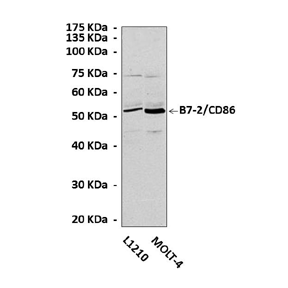Product Sheet CP10268
Description
BACKGROUND B7-1 (CD80) and B7-2 (CD86) are related immunoglobulin supergene family members that are expressed by multiple cell types involved in antigen presentation. Both B7-1 and B7-2 are constitutively expressed on dendritic cells and are upregulated on monocytes, macrophages, B cells, and T cells following activation.1 The upregulation on cells activated by various stimuli differs in terms of both the kinetics and density of expression of B7-1 and B7-2. B cells and monocytes, for example, upregulate B7-2 expression within 24 hr following activation with LPS, whereas B7-1 can only be detected 48 hr after activation, with the maximal cell surface expression being much less than observed with B7-2.
Generation of an effective immune response by T cells requires at least two signals from antigen-presenting cells: one mediated by specific antigen bound to MHC molecules and a second antigen-independent signal mediated by costimulatory ligands. The primary costimulatory receptor expressed on T cells is CD28. Interaction of CD28 with either of its ligands, B7-1 or B7-2, results in enhanced T cell proliferation and cytokine secretion. Interactions of either B7-1 or B7-2 with CTLA-4, a homolog of CD28 expressed on T cells, results in inhibition of T cell responses. A third costimulatory receptor, ICOS, was also identified that is a close structural homolog of CD28 and CTLA-4. ICOS is induced on activated T cells and can costimulate T cell proliferation and a different spectrum of T cell cytokine production, but it does not appear to act through binding to B7-1 or B7-2. Additionally, PD-1 is an inhibitory receptor, with two B7-like ligands.2 Futhermore, The distinct functions for B7-1 and B7-2 may be involved in their role in TH0, TH1, or TH2 differentiation. However, other studies suggest that B7-1 and B7-2 determine the magnitude of costimulatory signals rather than the outcome of TH subset differentiation. A third possibility is that, rather than having distinct CD28-dependent costimulatory roles, the key functional differences concern the strength and/or mode of binding of B7-2 and B7-1 to CD28 and CTLA-4. Interestingly, it was reported that Adenovirus serotype 3 utilizes B7-1 and B7-2as cellular attachment receptors, which suggests a mechanism whereby viral exploitation of these proteins as receptors may achieve both goals of cellular entry and evading the immune system.3
Generation of an effective immune response by T cells requires at least two signals from antigen-presenting cells: one mediated by specific antigen bound to MHC molecules and a second antigen-independent signal mediated by costimulatory ligands. The primary costimulatory receptor expressed on T cells is CD28. Interaction of CD28 with either of its ligands, B7-1 or B7-2, results in enhanced T cell proliferation and cytokine secretion. Interactions of either B7-1 or B7-2 with CTLA-4, a homolog of CD28 expressed on T cells, results in inhibition of T cell responses. A third costimulatory receptor, ICOS, was also identified that is a close structural homolog of CD28 and CTLA-4. ICOS is induced on activated T cells and can costimulate T cell proliferation and a different spectrum of T cell cytokine production, but it does not appear to act through binding to B7-1 or B7-2. Additionally, PD-1 is an inhibitory receptor, with two B7-like ligands.2 Futhermore, The distinct functions for B7-1 and B7-2 may be involved in their role in TH0, TH1, or TH2 differentiation. However, other studies suggest that B7-1 and B7-2 determine the magnitude of costimulatory signals rather than the outcome of TH subset differentiation. A third possibility is that, rather than having distinct CD28-dependent costimulatory roles, the key functional differences concern the strength and/or mode of binding of B7-2 and B7-1 to CD28 and CTLA-4. Interestingly, it was reported that Adenovirus serotype 3 utilizes B7-1 and B7-2as cellular attachment receptors, which suggests a mechanism whereby viral exploitation of these proteins as receptors may achieve both goals of cellular entry and evading the immune system.3
REFERENCES
1. Lenschow, D.J. et al: Ann. Rev. Immunol. 14:233-58, 1996
2. Carreno, B.M. & Collins, M.: Ann. Rev. Immunol. 20:29-53, 2002
3. Short, J.J. et al: Virol. 322:349-59, 2004
2. Carreno, B.M. & Collins, M.: Ann. Rev. Immunol. 20:29-53, 2002
3. Short, J.J. et al: Virol. 322:349-59, 2004
Products are for research use only. They are not intended for human, animal, or diagnostic applications.
Details
Cat.No.: | CP10268 |
Antigen: | Purified recombinant human B7-2/CD86 fragments expressed in E. coli. |
Isotype: | Mouse IgG1 |
Species & predicted species cross- reactivity ( ): | Human, Mouse, Rat |
Applications & Suggested starting dilutions:* | WB 1:1000 IP 1:50 IHC n/d ICC n/d FACS n/d |
Predicted Molecular Weight of protein: | 52 kDa |
Specificity/Sensitivity: | Detects B7-2/CD86 proteins without cross-reactivity with other related proteins. |
Storage: | Store at -20°C, 4°C for frequent use. Avoid repeated freeze-thaw cycles. |
*Optimal working dilutions must be determined by end user.
Products
| Product | Size | CAT.# | Price | Quantity |
|---|---|---|---|---|
| Mouse B7-2/CD86 Antibody: Mouse B7-2/CD86 Antibody | Size: 100 ul | CAT.#: CP10268 | Price: $413.00 |

